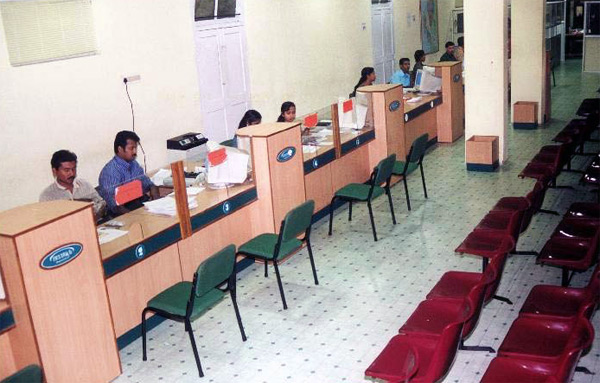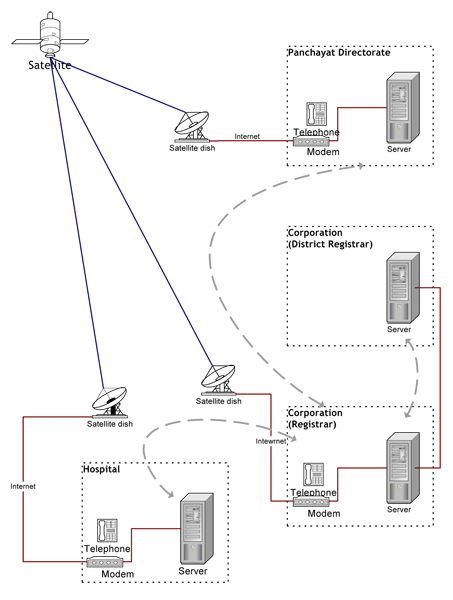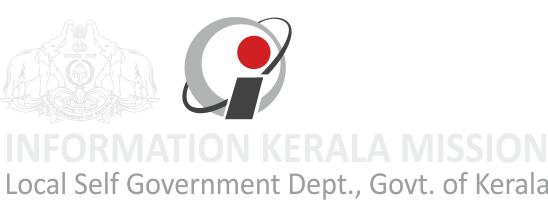Most of the E-Governance projects which have gained currency today, by and large give attention to front end processes only. Among these projects a majority emphasise on information access and transparency. There are some projects which concentrate on faster and efficient public transactions as well. Even in the few projects which undertake computerisation of the backend, the focus is in general on automation of processes in government as they exist. Re-designing of business processes and creating knowledge bases for decision making are far beyond the scope of contemporary egovernance projects. The Information Kerala Mission programme for computerisation of Local Self government Institutions is a striking deviation from this almost universal paradigm.
The Information Kerala Mission established in June 1999 as a sequel to the decentralised plan campaign has gone a long way in building and customising a few software applications addressing various facets of governance in local self government institutions, creating content for training the stakeholders in operationalising these applications and in drawing up a set of best practices for replicable and improvisable implementation through intensively planned pilots. The pilots of the mission have gone off the beaten path in addressing issues of administrative reforms and change management.
An outstanding input to the e-governance methodology from the mission had been the programme for reforming the civil registration system which has been shaped by drawing substantial contributions from best practices world over. E-governance programmes for computerising birth, death and marriage tried out so far in the country, to all intents and purposes, give attention to improving the speedier delivery of the certificates of registration. Improving the quality of statistical information on vital events, linking the registration process with community level identification systems, wiping out corruption in the process etc which are wider social objects of civil registration are quite often overlooked. All these aspects assume central stage in the mission’s civil registration restructuring programme..
The mission had been for the last three years running pilot projects for computerising birth, death and marriage registrations in five Grama Panchayats and four Municipal Corporations. Data entry of past records had been underway in three Municipal Corporations, three Municipalities and five Grama Panchayats. Around twenty one lakh records of registration have been so far handled by “Sevana”, the prestigious application of the Mission which has won the distinction of being the most coveted application for popular IT usage from the Computer Society of India (CSI_TCS Award 2001). District level pilots to handle another forty two lakh records have been initiated recently in Kasargod, Malappuram and Thiruvananthapuram Districts. Public access counters viz. “Janasevanakendrams” handling computerised issue of certificates had been in operation since January 2003 onwards in the four Corporations. See plate 1. In Malappuram District Akshaya kiosks are being tailored to facilitate this role.
The application has meanwhile gone through substantial revisions and a comprehensive “Sevana” product suite comprising six different applications has emerged. The applications handled by the suite comprise the Past Data entry module, Hospital Kiosk module, Local body Kiosk module, Local Self Government workflow module, District Registrar’s Office workflow module and the State Registrar’s Office workflow module. These applications cover all the ninety two odd different business processes relating to civil registration including periodical reports to the Registrar General of Births and Deaths unlike several other applications developed by various other Total Solution Providers and agencies in the country which at the best cover only nine.
A set of best practices for pre-processing of legacy records, data entry, verification and correction have been established based on an all-inclusive framework for quality control while effecting a transition from a manual system of book keeping to an electronic one. Apart from ensuring a faithful transition the application covers standardisation of data by adopting a series of standard codes for classifying statistical information. For instance the application facilitates classification of ‘Cause of Death’ using World Health Organisation’s standards for International Classification of Diseases (ICD-10). The best practices also cover criteria for acceptance of the electronic database, quality control for day to day counter operations and data audit processes for detecting fraudulent practices.
A very interesting strategy evolved in the best practices is an approach towards capturing data at the source for better control over data quality. Improvement of data quality not only perfects the civil registration and associated community databases but also avoids a large number of uncalled for correction transactions arising out of initial data capture. This in turn makes the public transactions simple, clear-cut and transparent, naturally reducing the chances for shady operations and corrupt practices. This is sought by linking the “Janasevanakendrams” with hospitals over the Internet. (See plate 2) A programme for linking forty government hospitals and one hundred and forty two private hospitals in the five Corporation areas with the respective “Janasevanakendrams” has been mooted. The objective shall be to make available birth and death certificates to the informants within twenty four hours of registration through the hospitals reporting the event. The Corporations have taken the lead and have held preliminary consultations with the various hospitals and a partnership is steadily emerging. In order to clear the way for this momentous occasion in streamlining service delivery in Local Self Government Institutions a campaign for wiping out backlog in issue of certificates for registrations done during the last ten years has been also planned.
Last but not the least another unique aspect of the project is the linkages with a programme for a community identity card linking Electoral ID data, Ration card data, Below Poverty Line data etc. This could later on be linked to the National Multipurpose Identity Card project as well. This aspect, very important from the point of view of building up a community database at the Local Self Government Institution level places the civil registration reform initiatives in Kerala on par with similar programmes in United States, Canada and the United Kingdom.
Maintaining programmes and institutions is more challenging than creating them. The mission looks forward to the model of citizen vigil and stakeholder participation that has stayed on with the decentralisation programme as the mainstay for sustainability. Resources for maintenance are quite often ignored and not built into the project, but this aspect also has been taken care of through beneficiary involvement.

Plate 1 - A view of Janasevanakendra in operation at Cochin Corporation

Plate 2 - Linkage between hospital, Janasevanakendram, Corporation Office and Directorate of Panchayats
Author: P.V. Unnikrishnan,
(Year 2005)
